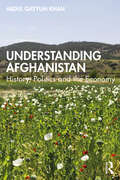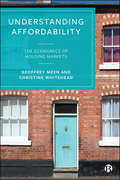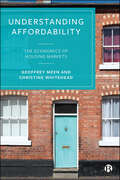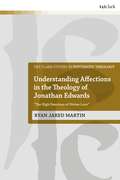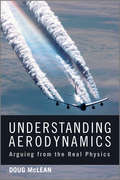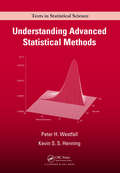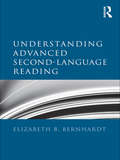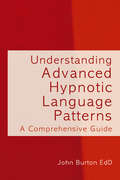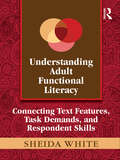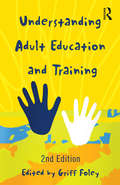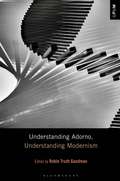- Table View
- List View
Understanding Afghanistan: History, Politics and the Economy
by Abdul QayyumThis book delves into the history of Afghanistan, its people, and its relationship with neighbours, to unravel the intricate politics and ethnolinguistic diversity of the country. It discusses the history of innumerable invasions which left imprints over the country and its people and (have) created a complex fabric of different ethnic, linguistic, religious and cultural groups. The volume looks at the various empires which warred over the land including the Persian, Greek, Mongol, and Sassanid dynasties as well as the later interferences by the British and the Russians and the emergence of the Taliban. It examines the correlations between war, power politics, religion, local governance, and the opium trade and economy in Afghanistan. The author through personal stories and anecdotes of his visits and journeys in Afghanistan provides a very rich and extensive view of Afghan politics, culture and history. The relationship between Afghanistan and Pakistan and Afghanistan’s unique position in the politics of the region is also a thread which runs through the entire book. This book will a great resource (be of interest) to researchers and students of politics, history, Central and South Asian Studies, war and international relations, political economy, and peace and reconciliation studies. It will also interest journalists, diplomats and international development organizations.
Understanding Affordability: The Economics of Housing Markets
by Geoffrey Meen Christine WhiteheadFor many younger and lower-income people, housing affordability continues to worsen. Based on the academic research of two distinguished housing economists – and stimulated by working with governments across the world - this wide-ranging book sets out clear theoretical and empirical frameworks to tackle one of today’s most important socio-economic issues. Housing unaffordability arises from complex forces and a prerequisite to effective policy is understanding the causes of rising house prices and rents and the interactions between housing, housing finance and the macroeconomy. The authors challenge many of the conventional wisdoms in housing policy and offer innovative recommendations to improve affordability.
Understanding Affordability: The Economics of Housing Markets
by Geoffrey Meen Christine WhiteheadFor many younger and lower-income people, housing affordability continues to worsen. Based on the academic research of two distinguished housing economists – and stimulated by working with governments across the world - this wide-ranging book sets out clear theoretical and empirical frameworks to tackle one of today’s most important socio-economic issues. Housing unaffordability arises from complex forces and a prerequisite to effective policy is understanding the causes of rising house prices and rents and the interactions between housing, housing finance and the macroeconomy. The authors challenge many of the conventional wisdoms in housing policy and offer innovative recommendations to improve affordability.
Understanding Affections in the Theology of Jonathan Edwards: "The High Exercises of Divine Love†? (T&T Clark Studies in Systematic Theology)
by Dr Ryan J. MartinThis volume argues that the notion of "affections†? discussed by Jonathan Edwards (and Christian theologians before him) means something very different from what contemporary English speakers now call "emotions.†? and that Edwards's notions of affections came almost entirely from traditional Christian theology in general and the Reformed tradition in particular. Ryan J. Martin demonstrates that Christian theologians for centuries emphasized affection for God, associated affections with the will, and distinguished affections from passions; generally explaining affections and passions to be inclinations and aversions of the soul. This was Edwards's own view, and he held it throughout his entire ministry. Martin further argues that Edwards's view came not as a result of his reading of John Locke, or the pressures of the Great Awakening (as many Edwardsean scholars argue), but from his own biblical interpretation and theological education. By analysing patristic, medieval and post-medieval thought and the journey of Edwards's psychology, Martin shows how, on their own terms, pre-modern Christians historically defined and described human psychology.
Understanding Affections in the Theology of Jonathan Edwards: “The High Exercises of Divine Love” (T&T Clark Studies in Systematic Theology)
by Ryan J. MartinThis volume argues that the notion of “affections” discussed by Jonathan Edwards (and Christian theologians before him) means something very different from what contemporary English speakers now call “emotions.” and that Edwards's notions of affections came almost entirely from traditional Christian theology in general and the Reformed tradition in particular. Ryan J. Martin demonstrates that Christian theologians for centuries emphasized affection for God, associated affections with the will, and distinguished affections from passions; generally explaining affections and passions to be inclinations and aversions of the soul. This was Edwards's own view, and he held it throughout his entire ministry. Martin further argues that Edwards's view came not as a result of his reading of John Locke, or the pressures of the Great Awakening (as many Edwardsean scholars argue), but from his own biblical interpretation and theological education. By analysing patristic, medieval and post-medieval thought and the journey of Edwards's psychology, Martin shows how, on their own terms, pre-modern Christians historically defined and described human psychology.
Understanding Aerodynamics: Arguing from the Real Physics (Aerospace Series #69)
by Doug McLeanMuch-needed, fresh approach that brings a greater insight into the physical understanding of aerodynamics Based on the author’s decades of industrial experience with Boeing, this book helps students and practicing engineers to gain a greater physical understanding of aerodynamics. Relying on clear physical arguments and examples, Mclean provides a much-needed, fresh approach to this sometimes contentious subject without shying away from addressing "real" aerodynamic situations as opposed to the oversimplified ones frequently used for mathematical convenience. Motivated by the belief that engineering practice is enhanced in the long run by a robust understanding of the basics as well as real cause-and-effect relationships that lie behind the theory, he provides intuitive physical interpretations and explanations, debunking commonly-held misconceptions and misinterpretations, and building upon the contrasts provided by wrong explanations to strengthen understanding of the right ones. Provides a refreshing view of aerodynamics that is based on the author’s decades of industrial experience yet is always tied to basic fundamentals. Provides intuitive physical interpretations and explanations, debunking commonly-held misconceptions and misinterpretations Offers new insights to some familiar topics, for example, what the Biot-Savart law really means and why it causes so much confusion, what “Reynolds number” and “incompressible flow” really mean, and a real physical explanation for how an airfoil produces lift. Addresses "real" aerodynamic situations as opposed to the oversimplified ones frequently used for mathematical convenience, and omits mathematical details whenever the physical understanding can be conveyed without them.
Understanding Aerodynamics: Arguing from the Real Physics (Aerospace Series #69)
by Doug McLeanMuch-needed, fresh approach that brings a greater insight into the physical understanding of aerodynamics Based on the author’s decades of industrial experience with Boeing, this book helps students and practicing engineers to gain a greater physical understanding of aerodynamics. Relying on clear physical arguments and examples, Mclean provides a much-needed, fresh approach to this sometimes contentious subject without shying away from addressing "real" aerodynamic situations as opposed to the oversimplified ones frequently used for mathematical convenience. Motivated by the belief that engineering practice is enhanced in the long run by a robust understanding of the basics as well as real cause-and-effect relationships that lie behind the theory, he provides intuitive physical interpretations and explanations, debunking commonly-held misconceptions and misinterpretations, and building upon the contrasts provided by wrong explanations to strengthen understanding of the right ones. Provides a refreshing view of aerodynamics that is based on the author’s decades of industrial experience yet is always tied to basic fundamentals. Provides intuitive physical interpretations and explanations, debunking commonly-held misconceptions and misinterpretations Offers new insights to some familiar topics, for example, what the Biot-Savart law really means and why it causes so much confusion, what “Reynolds number” and “incompressible flow” really mean, and a real physical explanation for how an airfoil produces lift. Addresses "real" aerodynamic situations as opposed to the oversimplified ones frequently used for mathematical convenience, and omits mathematical details whenever the physical understanding can be conveyed without them.
Understanding Advocacy for Children and Young People (UK Higher Education OUP Humanities & Social Sciences Health & Social Welfare)
by Jane Boylan Jane Dalrymple"A welcome contribution not only towards the development of advocacy policy and practice with children and young people across the UK and further afield but also towards the wider field of furthering children and young people's participation, individually and collectively in decisions affecting them. The authors ... deftly combine ... very pertinent theoretical perspectives with case studies and practical illustrations of how ... discourses play out in the real world of children and young people's lives. In so doing the book provides a powerful and timely reminder to practitioners, policy makers and commissioners of the importance of critical reflective practice in understanding the dynamics at play."Anne Crowley, Assistant Director (Policy and Research), Save the Children UK"This book is a serious read for anyone interested in the development of children's rights and advocacy. It has been thoroughly researched by two of the most highly respected commentators on the subject, and represents an authoritative and comprehensive guide. I would especially commend it to policy makers as providing a realistic account of what sometimes prevents good children's rights and advocacy practice, and for tackling very real and contentious issues such as 'best interest' principles getting in the way of giving full expression of children's own views."Mike Lindsay, National Co-ordinator of Children's Rights Alliance for EnglandPresenting children and young people's advocacy as an exciting, radical and constantly developing way of working, Boylan and Dalrymple explore its controversial and challenging nature through a comprehensive examination of the theory and practice of advocacy. Readers are invited to consider advocacy as a powerful tool for promoting change in attitudes towards children and young people. The development of meaningful participation in decision making and systemic change in the provision of services for children and young people is identified as key to this process. While advocacy now has a higher profile within health, welfare and education services, the authors argue for critical engagement with the dilemmas and paradoxes it continues to present. More traditional ways of advocacy practice are evaluated alongside newer approaches such as non-instructed advocacy and e-advocacy. Key issues explored include: An historical overview of advocacy within professional practice The development of independent advocacy The contested nature of advocacy Children and young people's participation Forms and models for the provision of advocacy The relationship between advocacy and anti-oppressive practiceThe authors draw on their own research and the experiences of young people, advocates and professionals working with children and young people to examine key messages and debates that have emerged. Case examples are used to illustrate advocacy dilemmas in a range of settings.Understanding Advocacy for Children and Young People is an essential text for advocates and professionals working with children and young people. It is also suitable as a key resource for health and social care practitioners, educators, commissioners and policy makers.
Understanding Advanced Statistical Methods (Chapman And Hall/crc Texts In Statistical Science Ser.)
by Peter WestfallProviding a much-needed bridge between elementary statistics courses and advanced research methods courses, Understanding Advanced Statistical Methods helps students grasp the fundamental assumptions and machinery behind sophisticated statistical topics, such as logistic regression, maximum likelihood, bootstrapping, nonparametrics, and Bayesian me
Understanding Advanced Second-Language Reading
by Elizabeth B. BernhardtWhat distinguishes this book is its broad, yet thorough, view of theory, process, and research on adult second-language reading. Offering extensive discussions of upper-register second-language texts (both expository and narrative) that adult second-language readers encounter daily across the globe, it also presents an assessment schema for second-language text comprehension as well as for the assessment of teaching. Understanding Advanced Second-Language Reading: includes languages other than English in the discussion of second language reading is firmly anchored in a theory of second language reading ─ the concept of compensatory processing emphasizes the multi-dimensionality and dynamic nature of L2 reading development focuses on comprehension of upper-register literary texts balances theory and instructional practices. Filling the need for a coherent, theoretically consistent, and research-based portrait of how literate adolescents and adults comprehend, and learn to comprehend, at greater levels of sophistication and whether that ability can be enhanced by instruction, this is a must-have resource for reading and second-language researchers, students, and teachers.
Understanding Advanced Second-Language Reading
by Elizabeth B. BernhardtWhat distinguishes this book is its broad, yet thorough, view of theory, process, and research on adult second-language reading. Offering extensive discussions of upper-register second-language texts (both expository and narrative) that adult second-language readers encounter daily across the globe, it also presents an assessment schema for second-language text comprehension as well as for the assessment of teaching. Understanding Advanced Second-Language Reading: includes languages other than English in the discussion of second language reading is firmly anchored in a theory of second language reading ─ the concept of compensatory processing emphasizes the multi-dimensionality and dynamic nature of L2 reading development focuses on comprehension of upper-register literary texts balances theory and instructional practices. Filling the need for a coherent, theoretically consistent, and research-based portrait of how literate adolescents and adults comprehend, and learn to comprehend, at greater levels of sophistication and whether that ability can be enhanced by instruction, this is a must-have resource for reading and second-language researchers, students, and teachers.
Understanding Advanced Hypnotic Language Patterns: A comprehensive guide
by John BurtonThis book dissects and describes the conceptual ingredients that construct hypnotic language. Clinical case examples and dozens of hypnotic language scripts are provided to illustrate the identified principles.
Understanding Adult Survivors of Domestic Violence in Childhood: Still Forgotten, Still Hurting
by Gill HagueDomestic violence experienced in childhood continues to have an enduring emotional impact into adulthood. The scars it leaves can impact on family lives, employment, and long-term emotional and mental health. This book explores the experiences of adult survivors of domestic violence in childhood. The authors draw on many years' experience at the forefront of the field to bring together current research, best practice guidance for those working with both adults and children, personal testimonies and creative writing from survivors. The book addresses how to work with children exposed to domestic violence to address the issues before they grow up, as well as guidance on working with adult survivors. The personal accounts and poems make real the research and practice guidance. This important book will be essential reading for all those working with survivors of domestic violence in childhood, including counsellors, social workers and therapists, as well as students, academics and policy makers.
Understanding Adult Survivors of Domestic Violence in Childhood: Still Forgotten, Still Hurting (PDF)
by Gill HagueDomestic violence experienced in childhood continues to have an enduring emotional impact into adulthood. The scars it leaves can impact on family lives, employment, and long-term emotional and mental health. This book explores the experiences of adult survivors of domestic violence in childhood. The authors draw on many years' experience at the forefront of the field to bring together current research, best practice guidance for those working with both adults and children, personal testimonies and creative writing from survivors. The book addresses how to work with children exposed to domestic violence to address the issues before they grow up, as well as guidance on working with adult survivors. The personal accounts and poems make real the research and practice guidance. This important book will be essential reading for all those working with survivors of domestic violence in childhood, including counsellors, social workers and therapists, as well as students, academics and policy makers.
Understanding Adult Functional Literacy: Connecting Text Features, Task Demands, and Respondent Skills
by Sheida White"This is a genuinely scholarly work ... It is based on [analysis of] the most up-to-date quantitative surveys that we have on adult literacy. These surveys are the gold standard in terms of documenting adult literacy in the United States ...The author analyzes these extensive surveys and puts them into a theoretical context in a way that has not been done before." – Rosemary J. Park, University of Minnesota "I don’t know of any book providing the same information. There is a shortage of literature in this area and the book is an excellent contribution." – Dolores Perin, Teachers College, Columbia University "The contribution of the theory is important – not only to adult literacy but to our understanding of the reading process at nearly every level ... Additionally, the application of multidimensional item response modeling to the new TTR theory offers a tantalizing view of how the predictive validity of a theory might be tested and used to provide practical results." – Larry Mikulecky, Indiana University Very often, individual differences in literacy performance are understood exclusively in terms of the characteristics of the reader. Drawing on a rich array of empirical research, the author presents a detailed and highly integrative new theory of functional literacy. The text-task-respondent (TTR) theory of functional literacy offers improved understanding of how successful performance on everyday literacy tasks involves a dynamic relationship among the text, the task, and the reader. This book will appeal primarily to assessment developers who wish to select tasks and texts of varying difficulty to yield more precise estimates of adult literacy; to researchers who study cognitive, linguistic, and discourse processes; and to teachers who want to find new ways to increase text comprehension among students, including English language learners and struggling readers. The text is appropriate for an advanced course in adult education, discourse analysis, educational measurement, educational psychology, literacy, or linguistics – or as a reference work for those interested in literacy.
Understanding Adult Functional Literacy: Connecting Text Features, Task Demands, and Respondent Skills
by Sheida White"This is a genuinely scholarly work ... It is based on [analysis of] the most up-to-date quantitative surveys that we have on adult literacy. These surveys are the gold standard in terms of documenting adult literacy in the United States ...The author analyzes these extensive surveys and puts them into a theoretical context in a way that has not been done before." – Rosemary J. Park, University of Minnesota "I don’t know of any book providing the same information. There is a shortage of literature in this area and the book is an excellent contribution." – Dolores Perin, Teachers College, Columbia University "The contribution of the theory is important – not only to adult literacy but to our understanding of the reading process at nearly every level ... Additionally, the application of multidimensional item response modeling to the new TTR theory offers a tantalizing view of how the predictive validity of a theory might be tested and used to provide practical results." – Larry Mikulecky, Indiana University Very often, individual differences in literacy performance are understood exclusively in terms of the characteristics of the reader. Drawing on a rich array of empirical research, the author presents a detailed and highly integrative new theory of functional literacy. The text-task-respondent (TTR) theory of functional literacy offers improved understanding of how successful performance on everyday literacy tasks involves a dynamic relationship among the text, the task, and the reader. This book will appeal primarily to assessment developers who wish to select tasks and texts of varying difficulty to yield more precise estimates of adult literacy; to researchers who study cognitive, linguistic, and discourse processes; and to teachers who want to find new ways to increase text comprehension among students, including English language learners and struggling readers. The text is appropriate for an advanced course in adult education, discourse analysis, educational measurement, educational psychology, literacy, or linguistics – or as a reference work for those interested in literacy.
Understanding Adult Education and Training
by Griff Foley'This is an impressive book that will be of wide interest to adult educators everywhere.Many of the book's contributors work at the University of Technology, Sydney - surely the world's pre-eminent institution for the study of adult learning, and the most open and generous location for debate. Its virtues are the book's.'Alan Tuckett, National Institute of Adult Continuing Education, UK'I am happy to endorse this book enthusiastically as being appropriate for a North American audience of adult educators.Though it's an intentionally introductory survey, it never talks down to readers, never condescends. On the other hand, it's not so intenationally erudite that it collagpses into theoretical posturing; it stays firmly grounded in and connected to practice.'Stephen Brookfield, University of St. Thomas, USAUnderstanding Adult Education and Training offers a broad overview of the field for adult educators and workplace trainers. It introduces the keys issues, debates and theories in a way which is relevant to practice. Its aim is to deepen readers' understanding of adult learning and education so that they can be better practitioners.Adult education is a diverse field so there is no single body of knowledge which is appropriate for all adult educators. Understanding Adult Education and Training introduces a wide range of formal theory from adult education and associated fields, and shows readers how they can use it their own circumstances.The first edition of this book has become a standard reference for students and professionals in Australia. This edition is fully revised and updated for an international readership.
Understanding Adult Education and Training
'This is an impressive book that will be of wide interest to adult educators everywhere.Many of the book's contributors work at the University of Technology, Sydney - surely the world's pre-eminent institution for the study of adult learning, and the most open and generous location for debate. Its virtues are the book's.'Alan Tuckett, National Institute of Adult Continuing Education, UK'I am happy to endorse this book enthusiastically as being appropriate for a North American audience of adult educators.Though it's an intentionally introductory survey, it never talks down to readers, never condescends. On the other hand, it's not so intenationally erudite that it collagpses into theoretical posturing; it stays firmly grounded in and connected to practice.'Stephen Brookfield, University of St. Thomas, USAUnderstanding Adult Education and Training offers a broad overview of the field for adult educators and workplace trainers. It introduces the keys issues, debates and theories in a way which is relevant to practice. Its aim is to deepen readers' understanding of adult learning and education so that they can be better practitioners.Adult education is a diverse field so there is no single body of knowledge which is appropriate for all adult educators. Understanding Adult Education and Training introduces a wide range of formal theory from adult education and associated fields, and shows readers how they can use it their own circumstances.The first edition of this book has become a standard reference for students and professionals in Australia. This edition is fully revised and updated for an international readership.
Understanding Adult Attachment in Family Relationships: Research, Assessment and Intervention
by Antonia Bifulco Geraldine ThomasAttachment theory has become a key focus of both research and practice in understanding and treating psychological and social risk for marital and relationship problems, parenting and clinical disorders. In particular, adult attachment style is a key explanatory factor for understanding problems in human relationships. This practical book introduces and explains an easily accessible assessment tool for adult attachment style, the Attachment Style Interview (ASI). Based on extensive research study, it discusses appropriate interventions and case assessments that can be made to help families in need. Simpler than the Adult Attachment Interview, which requires expert administration, the ASI is an invaluable and evidence-based resource. Presenting clear and concise descriptions of the measure and summaries of the attachment models developed, this text provides discussions of its relevance for different practice contexts, and uses a range of worked case studies to illustrate its principles and applications. It details attachment issues in different relationship domains to cover areas of risk and resilience relevant for practice such as: Adult depression and anxiety and stress models Partner difficulties including domestic violence Childhood neglect and abuse as a source of attachment problems Parenting and intergenerational transmission of risk Interventions, service application and use in family therapy. Understanding Adult Attachment in Family Relationships provides an important reference for all practitioners working with children, adolescents and families, especially those undertaking further study.
Understanding Adult Attachment in Family Relationships: Research, Assessment and Intervention
by Antonia Bifulco Geraldine ThomasAttachment theory has become a key focus of both research and practice in understanding and treating psychological and social risk for marital and relationship problems, parenting and clinical disorders. In particular, adult attachment style is a key explanatory factor for understanding problems in human relationships. This practical book introduces and explains an easily accessible assessment tool for adult attachment style, the Attachment Style Interview (ASI). Based on extensive research study, it discusses appropriate interventions and case assessments that can be made to help families in need. Simpler than the Adult Attachment Interview, which requires expert administration, the ASI is an invaluable and evidence-based resource. Presenting clear and concise descriptions of the measure and summaries of the attachment models developed, this text provides discussions of its relevance for different practice contexts, and uses a range of worked case studies to illustrate its principles and applications. It details attachment issues in different relationship domains to cover areas of risk and resilience relevant for practice such as: Adult depression and anxiety and stress models Partner difficulties including domestic violence Childhood neglect and abuse as a source of attachment problems Parenting and intergenerational transmission of risk Interventions, service application and use in family therapy. Understanding Adult Attachment in Family Relationships provides an important reference for all practitioners working with children, adolescents and families, especially those undertaking further study.
Understanding Adorno, Understanding Modernism (Understanding Philosophy, Understanding Modernism)
by Robin Truth GoodmanHaving studied philosophy at a time when its traditions were being seriously uprooted by the atrocities of World War II, Theodor Adorno had an enormous impact on thinking about aesthetics at a transitional historical moment when the philosophy of science and leftist politics were looking for new ground. Moreover, with his focus on the rise of commercial culture and its effects on identity-construction, Adorno can be said to have reinvigorated modernist concerns by introducing the prevailing terms in our contemporary versions of cultural politics and cultural studies. Understanding Adorno, Understanding Modernism traces Adorno's social and aesthetic ideas as they appear and reappear in his corpus. As per other volumes in the series, this book is divided into three parts. The first, “Adorno's Keywords,” is organized by the aesthetic terms around which Adorno's philosophy circulates. The second section is devoted to “Adorno and Aesthetics.” While Adorno's philosophical viewpoints influenced modernism's evolution into the 21st century, the history of modernist aesthetics also shaped his philosophical approaches. The third and final part, “Adorno's Constellations,” discusses how aesthetic form in Adorno's thinking underlies the terms of his social analysis.
Understanding Adorno, Understanding Modernism (Understanding Philosophy, Understanding Modernism)
Having studied philosophy at a time when its traditions were being seriously uprooted by the atrocities of World War II, Theodor Adorno had an enormous impact on thinking about aesthetics at a transitional historical moment when the philosophy of science and leftist politics were looking for new ground. Moreover, with his focus on the rise of commercial culture and its effects on identity-construction, Adorno can be said to have reinvigorated modernist concerns by introducing the prevailing terms in our contemporary versions of cultural politics and cultural studies. Understanding Adorno, Understanding Modernism traces Adorno's social and aesthetic ideas as they appear and reappear in his corpus. As per other volumes in the series, this book is divided into three parts. The first, “Adorno's Keywords,” is organized by the aesthetic terms around which Adorno's philosophy circulates. The second section is devoted to “Adorno and Aesthetics.” While Adorno's philosophical viewpoints influenced modernism's evolution into the 21st century, the history of modernist aesthetics also shaped his philosophical approaches. The third and final part, “Adorno's Constellations,” discusses how aesthetic form in Adorno's thinking underlies the terms of his social analysis.
Understanding Adolescents’ Political Agency: Examining How Political Interest Shapes Political Development (Studies in Adolescent Development)
by Håkan StattinThis ground-breaking volume shows that young people largely shape their own political development, and that to understand young people's political development, we must consider their political agency.Håkan Stattin explores the findings of an extensive longitudinal study of the political socialization of young people in Sweden from the ages of 13 to 28, which shows that, contrary to popular belief, it is not parents, peers, teachers or other key adults who are the primary agents in shaping young people's political development; it is their own self-directed political interest. Given that political interest is both an input and an output, the book examines how political interest affects young people's political interactions with their parents, and why young people and their parents perceive these interactions differently. It covers key issues such as the impact of political-interest-triggering events and civil unrest, the role of school and peers, parental involvement and the path from political interest to future political and civic engagement.Launching a new field of research internationally, this volume is essential reading for researchers, students, educators, and policy developers interested in young people's political and civic attitudes, engagement, communication, core values and the emergence of intrinsic political sophistication.
Understanding Adolescents’ Political Agency: Examining How Political Interest Shapes Political Development (Studies in Adolescent Development)
by Håkan StattinThis ground-breaking volume shows that young people largely shape their own political development, and that to understand young people's political development, we must consider their political agency.Håkan Stattin explores the findings of an extensive longitudinal study of the political socialization of young people in Sweden from the ages of 13 to 28, which shows that, contrary to popular belief, it is not parents, peers, teachers or other key adults who are the primary agents in shaping young people's political development; it is their own self-directed political interest. Given that political interest is both an input and an output, the book examines how political interest affects young people's political interactions with their parents, and why young people and their parents perceive these interactions differently. It covers key issues such as the impact of political-interest-triggering events and civil unrest, the role of school and peers, parental involvement and the path from political interest to future political and civic engagement.Launching a new field of research internationally, this volume is essential reading for researchers, students, educators, and policy developers interested in young people's political and civic attitudes, engagement, communication, core values and the emergence of intrinsic political sophistication.
Understanding Administrative Law in the Common Law World
by Paul DalyAround the common law world, the law of judicial review of administrative action has changed dramatically in recent decades, accelerating a centuries-long process of incremental evolution. This book offers a fresh framework for understanding the core features of contemporary administrative law. Through comparative analysis of case law from Australia, Canada, England, Ireland, and New Zealand, the author develops an interpretive approach by reference to four values: individual self-realisation, good administration, electoral legitimacy, and decisional autonomy. The interaction of this plurality of values explains the structure of the vast field of judicial review of administrative action: institutional structures, procedural fairness, substantive review, remedies, restrictions on remedies, and the scope of judicial review. Addressing this wide array of subjects in detail, the book demonstrates how a pluralist approach, with the values being employed in a complementary and balanced fashion, can enhance our understanding of administrative law. Furthermore, such an approach can guide the future development of the law of judicial review of administrative action, a point illustrated by a careful analysis of the unsettled doctrinal area of legitimate expectation. The book closes by arguing that the author's values-based, pluralist framework supports the legitimacy of contemporary administrative law which, although sometimes called into question, facilitates the flourishing of individuals, of public administration, and of the liberal democratic system.
